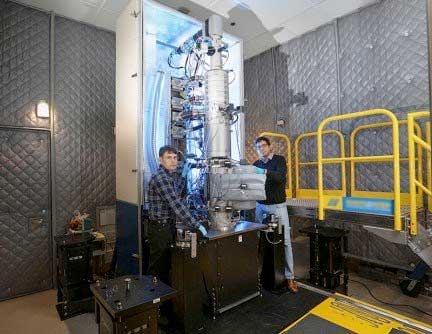| Posted: May 14, 2018 |
Huge 'thermometer' takes temperatures of tiny samples
(Nanowerk News) The tool is a 13-foot-tall electron microscope nicknamed a “quantum spectrometer.” Scientists took advantage of spectroscopic techniques that have high spatial resolution when coupled with a narrow probe. They measured the local temperature of a material from a small volume. The width of the volume was about a billionth of a meter wide (Physical Review Letters, "Temperature measurement by a nanoscale electron probe using energy gain and loss spectroscopy").
|
 |
| The picture shows scientists Andrew Lupini (left) and Juan Carlos Idrobo (right) with the microscope that made it possible. The new microscope is called a Nion HERMES. It has extremely high energy resolution and a narrow electron beam. Using spectroscopic techniques called electron energy loss and gain spectroscopy, researchers determined the temperature of a material at the nanoscale. Knowing nanoscale temperatures could reveal insights to advance electronics, catalysis, and energy storage and generation technology. (Image: Oak Ridge National Laboratory)
|
|
Useful, yet unusual. At the nanoscale, materials don’t behave as they usually do (that is, when they are in larger quantities). For example, a block of gold is inert, but gold at the nanoscale is a catalyst. This discovery promises to improve our ability to understand physical and chemical behaviors that arise at the nanoscale. This tool could map atomic-scale vibrations due to heat. The vibrations affect microelectronic devices, semiconducting materials, and other technologies.
|
|
Atoms are always shaking. The higher the temperature, the more the atoms shake. In this study, scientists used a specialized instrument made by the Nion Company that produces images with both high spatial resolution and great spectral detail. The instrument is called HERMES, short for high-energy-resolution, monochromated, electron-energy-loss-spectroscopy scanning transmission electron microscope.
|
|
Scientists used HERMES to measure the temperature of semiconducting hexagonal boron nitride. They observed atomic vibrations that correspond to heat in the material. They characterized nanoscale environments at room temperature to about 1300 degrees Celsius (2372 degrees Fahrenheit) using a newly developed Protochips heating device. Unlike typical thermometers, the HERMES “thermometer” does not require prior temperature calibration. The experimenter need only know the energy and intensity of an atomic vibration in a material—both of which are measured during the experiment.
|
|
This experiment used electron energy gain and loss spectroscopies to study atomic vibrations. In electron energy loss spectroscopy, the microscope’s electron beam loses energy as it passes through the sample. In contrast, in energy gain spectroscopy, the electrons gain energy from interacting with the sample. The scientists calculated the ratio between energy gain and loss to derive the temperature of the tiny portion of the sample through which the electrons traveled. This gives the “thermometer” nanoscale resolution.
|
|
It may now be possible to characterize local temperature during phase transitions in materials. HERMES could be useful for studying devices working across a wide range of temperatures, from electronics operating under ambient conditions to vehicle catalysts performing at over 300 degrees Celsius (around 570 degrees Fahrenheit).
|

